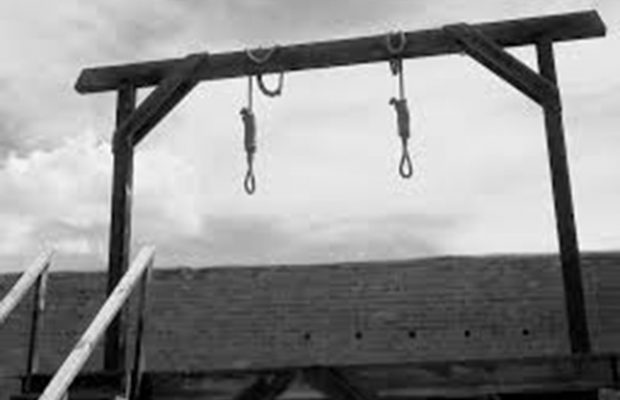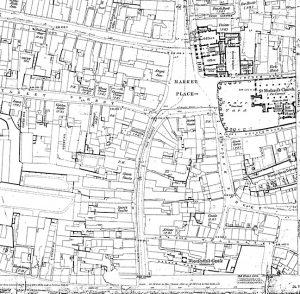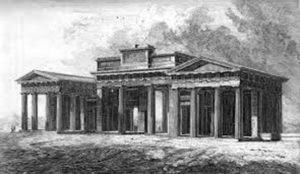- Home
- News
- What’s On
- Activities for Children
- Arts & Crafts
- Autos and Bikes
- Business events
- Car Boot & Auctions
- Charity events
- Churches & Religious
- Comedy
- Dance
- Days out & Local interest
- Education
- Exhibition
- Film
- Gardening & Horticulture
- Health
- Markets & Fairs
- Music
- Nature & Environment
- Spiritual
- Sport
- Talks and Discussions
- Theatre and Drama
- Business
- Local Information
- Jobs
- Deaths
- Charity events
- Contact Us
“An unparalleled act of barbarity”

William Stanway, 31, and Ann Mellor, 36, had lived together as man and wife for ten years when this story opens in mid-September, 1880. They pursued an uncertain and itinerant calling: he a maker and hawker of besoms, and she a hawker of tin-ware. Some years earlier they had adopted a little girl, now aged eight or nine, named Sarah Ann Blunt, who was aware of her adopted status but encouraged to regard both as her parents.
Since these two adults worked independently of each other it seems likely the child accompanied her ‘mother’ in the door-to-door visits for she could carry light burdens and might even have been used as a sympathetic ply to assist sales. Whenever the child’s lack of schooling was queried, Stanway would say, “She has been to school but could not learn anything.” Hardly complimentary to the bright child.
These backwards and forwards visits to Macclesfield from their home in Staffordshire had commenced seven years previously and on each occasion they had lodged with fellow hawker John Williamson and his partner, widow Ann Sutton, in Townley Street, and once again they were made welcome and stated their intention of staying until the new year. It is possible this visiting ritual was inspired by sentiment, for although Stanway was regarded, generally, as a Staffordshire man born and bred, those closer to his family claim he was born in Macclesfield, in a Row off Gunco Lane. His father, who came from Biddulph, afterwards went to Newcastle, Staffs.
Two weeks after arriving in Macclesfield – that is to say during the town’s Wakes holiday – due to their hosts’ influence they secured tenancy of a small house a mere two minutes’ walk away: house 4, Court 4, George Street East, on the other side of Sunderland Street. It had two rooms, one above the other, and John Williamson supplied their basic requirements except a bed, and so an improvised version was fashioned on the upstairs floor.
It is a poignant paradox that Mr Williamson’s kindness in gaining independence in this way for Stanway who, hitherto, had been restrained by a necessary degree of decorum as a lodger, was unfettered now to release the demons in his character whenever he chose for he had been before the magistrates for being drunk and disorderly and had served a term of six months’ imprisonment for a callous assault on a man. That change of address was to cost Ann Mellor her life in the most brutal way.
The weeks leading up to Christmas passed peacefully enough with Stanway conducting his business out of town and Ann Mellor operating locally. With Christmas Day one week away, on Saturday, December 18, Ann decided to rest from her labours but Stanway declared he would work for a final week, out of town, and return on Christmas Eve. He even stipulated on which train he would arrive back in town. Dutiful partner that she was, on Christmas Eve she went to greet him and was understandably saddened by his non-appearance.
That evening Ann Mellor and the child were invited to spend the night in Townley Street.
At eight o’clock on Christmas Day morning Stanway returned from his travels and on learning of his arrival Ann Mellor came downstairs immediately, relieved by his return. John Williamson supplied the first liquor of the day while they discussed how best to celebrate. Stanway insisted the first port of call was to be his own little house as his two brothers and a friend were joining them there. He gave Ann Mellor a guinea and a few coins to go shopping that morning, priority purchases to be a new pair of boots for the child and some food. Ann Sutton volunteered to accompany her.
The men left them to join the rest of their party at Stanway’s house, drinking ale until it was opening time at the Silk Mill Tavern. Their drinking spree lasted from early morning until late in the afternoon and may well have included other nearby venues such as The Jolly Sailor, Sunderland Street, The Blue Bell Inn, Mill Lane and The Pineapple, Watercotes.
At about half-past twelve, having completed their shopping, Ann Mellor – who, it has to be said, was no stranger to strong drink – invited Ann Sutton to join her at the Silk Mill Tavern, by which time their menfolk were elsewhere. They drank together until two-thirty, at which point Ann Sutton took her leave and Ann Mellor continued drinking alone.
At some point during the remainder of the afternoon Ann Mellor and the men’s group came together for a spell and finally separated shortly after four-thirty, Stanway and she returned to their home.
Soon there was the sound of fierce argument, both verbal and physical, from house 4, Court 4, and became so intense a crowd began to gather as the likelihood of a spectacle seemed imminent. And so it proved . . .
First, the child came running from the house. She would say later that the sight of her father beating her mother with a poker was too painful to witness. Then Mellor made her escape from the house intent on seeking access to a neighbour’s house for safety, but with Stanway in close pursuit they both fell into the house, to the consternation of the lady-occupier, with Stanway uppermost, attacking his poor partner with a frenzied fist and boot assault, blacking one of her eyes.
At last she was able to get away and ran down the court but he caught up with her, unrelenting in his punishment bruising her in the most terrible way. One of the watching crowd called him a murderous villain. His victim was heard to shout out a remark that contained the term ‘clem vengeance’, which referred to her occasional decision not to prepare food for him as a reprisal for cruel treatment. Stanway was heard to reply, ‘Don’t talk to me about “clem vengeance” when I have walked from Newcastle this morning and have had nothing to eat, and have given you money to buy meat.’
Seeing a face in the crowd she recognised, she called out, ‘Jack, dos’t hear that? Was I likely to get meat for a whole house full of drunken men?’ Stanway was encouraged to return to his home and did so uttering the violent expression that if he saw Ann Mellor again that day he would ‘kick her b- entrails out.’
The battered woman took her child by the hand and made her way to the sanctuary of the house in Townley Street, only to find John Williamson and his partner Ann Sutton were out. Having trudged back across Sunderland Street the forlorn woman and her ward made for the home of a friendly neighbour named Tom Byrne, a young man always willing to offer hospitality but regarded with suspicion by Stanway. In the recent past Stanway had made it quite clear he objected strongly to her associating with Byrne. Her answer had been that since it was an innocent friendship, as a mature woman, five years senior in age to Stanway, she was well able to make decisions of her own, thank you very much!
Byrne already had two guests but was happy to have the woman and child join them. During their stay of about half an hour the child was sent out on three occasions with a quart jug for ale, after which the pair returned to their home and the child and her weary mother went to bed.
Some time between nine and ten o’clock Stanway was sitting, silent and brooding, beside the fire. What happened during the next few minutes we have only the child’s own testimony to assist us. She said that about a quarter to ten her father called out to her mother that if she didn’t come downstairs he would bring a red-hot poker to her! The poor woman, in dread of his violence, hastily put on a petticoat and descended the stairs while the child remained watchful from above.
As she neared the bottom of the stairs Stanway withdrew the glowing rod from the fire – confirmation it had been heated before she had shouted his threat – and as she reached the bottom of the stair, with a sudden lunge he thrust the red-hot iron into her abdomen, a deed described by the Macclesfield Courier & Herald as ‘an unparalleled act of barbarity’ and who would argue with that description? Seeing her mother collapse in pain, her head resting on the bottom step of the stairs, the child hastened downstairs and filled a cup with water hoping to revive her mother, but for a short while she appeared to be unconscious with her eyes wide open; a condition the youngster described as ‘a fit’.
Eventually, the injured woman was able to drink, and surprisingly, after a few minutes’ rest, got to her feet in a stooping posture and, beckoning the child to follow her, left the house, with Stanway sitting by the fire, the poker cooling in the hearth.
The scantily-clad mother and child made their way once again to their friends’ house in Townley Street. Mrs Elizabeth Blackley, a close friend from Cross Street, was also a visitor that night. Arriving at about ten o’clock Ann Mellor said to her, ‘Oh Bessie, Billie has burned my belly with a red-hot poker.’ Ann Sutton was present and declared, ‘I’ve never heard such a thing in all my life as Billie to burn thee so.’
Mrs Blackley stayed the night and provided drinks of tea and water whenever the sick woman, who shared the bed with Ann Sutton, required them. For warmth throughout the night little Sarah Anne slept with ‘Daddy Jim’ (John Williamson).
The next morning, Boxing Day, Williamson met Stanway on the street corner, holding his arm across his body. Asked what was the matter, Stanway replied, ‘I dunna know. I think I’ve put my shoulder out or broken it, or summat, and nearly spoilt her with the poker.’ Stanway then walked back with Williamson to his home and went upstairs. When he came down he said to his host, ‘She’s been to Byrne’s – she was there last night, and she’s owned to it.’ And paid a price for it, he might have added.
Ann Mellor, her condition in decline, made a supreme effort and returned to her own home, on foot, at about 5pm that same day. There was talk suggesting that perhaps she should be seen by a doctor, but the sick woman would not allow it, saying, ‘No, I’ll have no doctor.’ She told Stanway. ‘It will go worse with you if I have a doctor and he sees this black eye. You’ll be locked up.’
The next day, late in the evening, Ann Mellor’s condition was such that she was beyond objecting and William Stanway implored John Williamson to seek out a willing doctor, not so easy in those days, but at a quarter to eleven his persistence paid off and Mr George Bland, surgeon, was taken to the little house in Court 4. There were two women in the upstairs room and several men below. Within moments he confirmed that the sick woman had been brought to treat was dead but did not convey that fact to anyone present. He did ask how the woman in the bed had suffered a black eye and was told she had probably been drinking and had fallen down the stairs. In the circumstances Mr Bland was duty-bound to inform the police immediately of Ann Mellor’s death in suspicious circumstances.
A surprising feature at this point was that, for reasons best known to herself, Ann Sutton, John Williamson’s partner in Townley Street, foolishly chose to assist William Stanway to extricate himself from his crime in any way she could by withholding from the police true facts, and embellishing his untruths. It was all to no avail. Early the next morning Stanway was arrested and an inquest into Mellor’s death was held in the Town Hall in that same week. William Stanway was found guilty of wilful murder and the Coroner censured Ann Sutton for the unsatisfactory way she had given her evidence and warned her to be careful of how she gave evidence in future.
The Coroner then formally committed Stanway to take his trial at the next Assizes at Chester.
Stanway was put upon his trial during the last week of January and the first week of February, 1881. He appeared to be totally disinterested in the proceedings and the outcome was wholly predictable. The jury retired at half-past three o’clock and returned into Court in half an hour when they announced a verdict of wilful murder against the prisoner.
The prisoner, in answer to the usual question why the Court should not pass sentence upon him, said, ‘I have not done it, not that I know of. If I must die this moment I know nothing at all about it.’
Having assumed the black cap his Lordship spoke at some length to Stanway. Key points he commented upon were that Stanway might well have caused his victim’s death by kicking before resorting to the red-hot poker, and that the poor woman who lived with him had sufficient compassion to try to shield him from the consequences of his own crime. ‘Under such circumstances,’ said his Lordship, ‘I have no alternative, and the interests of society imperatively require, that I pass upon you sentence of death.’ His Lordship then passed sentence of death in the usual form.
William Stanway was hanged on February 21, 1881.



You must be logged in to post a comment Login